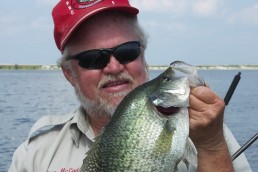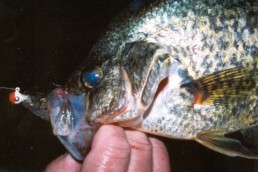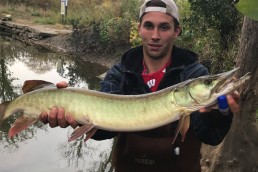Tough-to-track Crappies After the Spawn
SHARE THIS POST
Steve McCadams has been guiding and studying crappies for 30 years and is recognized as an authority on the subject. Don’t be disheartened when he says, “Post-spawn is one of the toughest times of the year to locate crappies. Once they get through spawning they are very stressed and post-spawn crappies are scattered until they get back to a deep-water pattern.”
Take heart—Steve has solutions to this problem.
Transition blues
Instead of staying around stumps, stake beds or brush piles, crappies suspend over nothing in wide-open areas. This is the post-spawn “transition blues.” You may find some loosely associated with a ledge but not holding tight on it. They may be 8 to 10 feet deep in the middle of nowhere or suspended 5 to 10 feet deep over 20 feet of water or may be roaming around.
It isn’t exactly aimless roaming; they are roaming back to deeper water. Crappies will stair-step back to the deep water. To a degree, they use a creek channel as a highway or a marker to follow to deep water, but they aren’t tight on it like they were coming in. They aren’t in schools either. A few may wander into each other and form loose associations. This trend continues until they get back to the drop-offs or ledges in 15 to 20 feet of water and reform schools. Their usual feeding pattern begins when they get acclimated to deeper water. The process takes two to four weeks.
Locating scattered crappies
The first thing McCadams suggests we do is try structure that has previously held crappies to prove they aren’t there. If we catch one or two where we used to catch a dozen and we fish 10 to 15 such areas with only five fish to show for it, we should then recognize that must fish another pattern.
“That’s when the spider rig makes your work easier,” Steve says. “Of course, most of us would rather hold the pole and feel that fish hit, but you can’t knock the success of the spider rig. It’s probably the most effective technique for post-spawn crappies. It’s successful because you’re covering all the water along a 200- or 300-yard flat, bar or a ledge. The spider rig effectively combs the water for scattered fish.”
It’s also an excellent technique on a lake you’re not familiar with. This rig can cover a lot of water in a short time trolling. You do need a topo map to locate the flats no deeper than 20 feet near the mouths of creeks or near the main channel on flatland and hill-land reservoirs. You may need to set your rigs deeper in a highland reservoir.
Troll these areas thoroughly. Your depth finder will show you the ledges and drops. Use marker buoys to keep your boat trolling over the creek mouths, flats and ledges. Trust your depth finder. If it shows fish at 10 feet, you don’t need to have your bait at 18 feet.
How to spider-rig
Ten- to 12-foot crappie poles with fly reels or South Bend Line Keepers are a good choice. The Line Keeper lets your line off in 1-foot increments or you can mark your line with a marking pen at 1- or 2-foot increments to keep track of how deep you are fishing. This is important when spider-rig fishing because you’re trying to cover more than one depth.
Spread these lines out in front of your boat and slowly move over the structures mentioned. You don’t want to overload your boat, but the more anglers fishing, the more water you can cover with each pass. Next, set your bait at different depths. If you’re alone you may want to set your baits about 2 feet apart in stained water and farther apart in clear water. Since crappies can see up better than down, it’s better to fish shallow than deep.
Placing two or three hooks on your line also allows you to sample more depths. A bell sinker on the bottom and 1/0 hooks tied about 18 inches apart allows you to probe about 5 vertical feet of the water column. With three poles about 6 feet apart, you can cover a horizontal path of about 20 feet. Water clarity determines how far to place your vertical lines from each other. Lower a white cup or plug overboard and watch it until it disappears. Measure the distance then double it. That is how deep light is penetrating. If you are fishing deeper than that, reduce the distance between your vertical lines. This is where you have to consider the conditions and use your own judgment.
Are you enjoying this post?
You can be among the first to get the latest info on where to go, what to use and how to use it!
Minnows, especially shiners, are good baits for spider-rig fishing. Lively minnows add vibration to the water and light flashes from their scales, two factors that attract fish. If you’re using jigs, set one near the bottom, the next one 2 or 3 feet above that, and the last one 1 or 3 feet above the middle one. You’re covering the vertical zone well with a 15-foot-wide swath. You can also use a combination of jig and minnow. An effective method is to use two hooks on a line, a minnow on the bottom hook and a jig 18 inches above the minnow. That way, you let the fish decide which it wants.
Steve says color always makes a difference. If you and your partner have six poles with two jigs on each rig, try different combinations of colors. Try red and chartreuse on top with pink and pearl on the bottom. If you catch 10 fish and seven were caught on one color, that’s a good indication you need to switch all your jigs to the producing colors.
“You can be stubborn if you want to and say color doesn’t make a difference, but after a while you might figure out those fish are trying to tell you something,” McCadams said. “I suggest you put several contrasting colors out and let the fish tell you what color they want. It’s easy to replace the non-producing jigs with colors that work. Crappies are very finicky and post-spawn crappies are even more stubborn. They aren’t aggressive enough to dart out and run a bait down like they would back during the spring.”
The color of the water makes a difference in the color of jig to use. If the white cup or plug disappears at less than 2 feet, the water is muddy; at less than 4 feet, it’s stained. If you can see the white object in more than 4 feet, consider the water clear.
Steve recommends using something very dull or subdued like a motor oil color in clear water; smoke with flakes is another good choice. Chartreuse shades work well in stained water too because light transmission is reduced and it takes more light reflection to be seen. In muddy water, use loud-colored skirts on a bright red head. Finding the right color may take some experimenting he says, but if you use an unpainted lead head, select the one with the bright silvery color, like a minnow’s head.
Road Runners are popular for trolling. They have a small spinner that works real well for slow trolling and you can also use twister tails. For using a jig or minnow, some people like one or the other, but sometimes a jig tipped with a minnow is just what they want. Let’s face it. The crappies get to make the rules and they want different things at different times.
Bottom line
You’ve got to think about color, the size of your baits, depths and structures the fish may be suspended in, over or near. The size of your baits makes a difference, as bigger crappies may take a 3-inch shiner while an 8-ounce crappie may want a small tuffy. Or, if you’re using jigs, try a range from 1/16 to 1/4 ounce with 2- to 4-inch curly-tail grubs.
Six- or 8-pound-test line is good for spider-rig trolling; a large-diameter line will bow too much. If you’re catching fish with 10 feet of line out with a bow in it you may be catching fish at 5 feet. If you stop to fish that spot with 10 feet of line out you are below the crappies. Remember, they don’t look down they look up. If you want to use heavier lines you’ll have to put on more weight to keep the line vertical.
Stained water keeps fish shallow, and clear water drives them deep, and the fish feel more comfortable or secure in stained water. And flatland lakes will have more color than the hill-land and highland lakes.
Don’t be disheartened during the post-spawn season and try Steve’s ideas. He makes a living catching crappies year ‘round.
MWO
SHARE THIS POST
Did you enjoy this post?
You can be among the first to get the latest info on where to go, what to use and how to use it!
Vernon Summerlin
For more than 30 years, Vernon Summerlin has produced outdoor articles and books that can be found on Amazon; most recently How to Analyze a Bass Hole: Think and Catch’em! He is the recipient of more than 40 awards for magazine and newspaper articles, TV, radio, photography and books.



